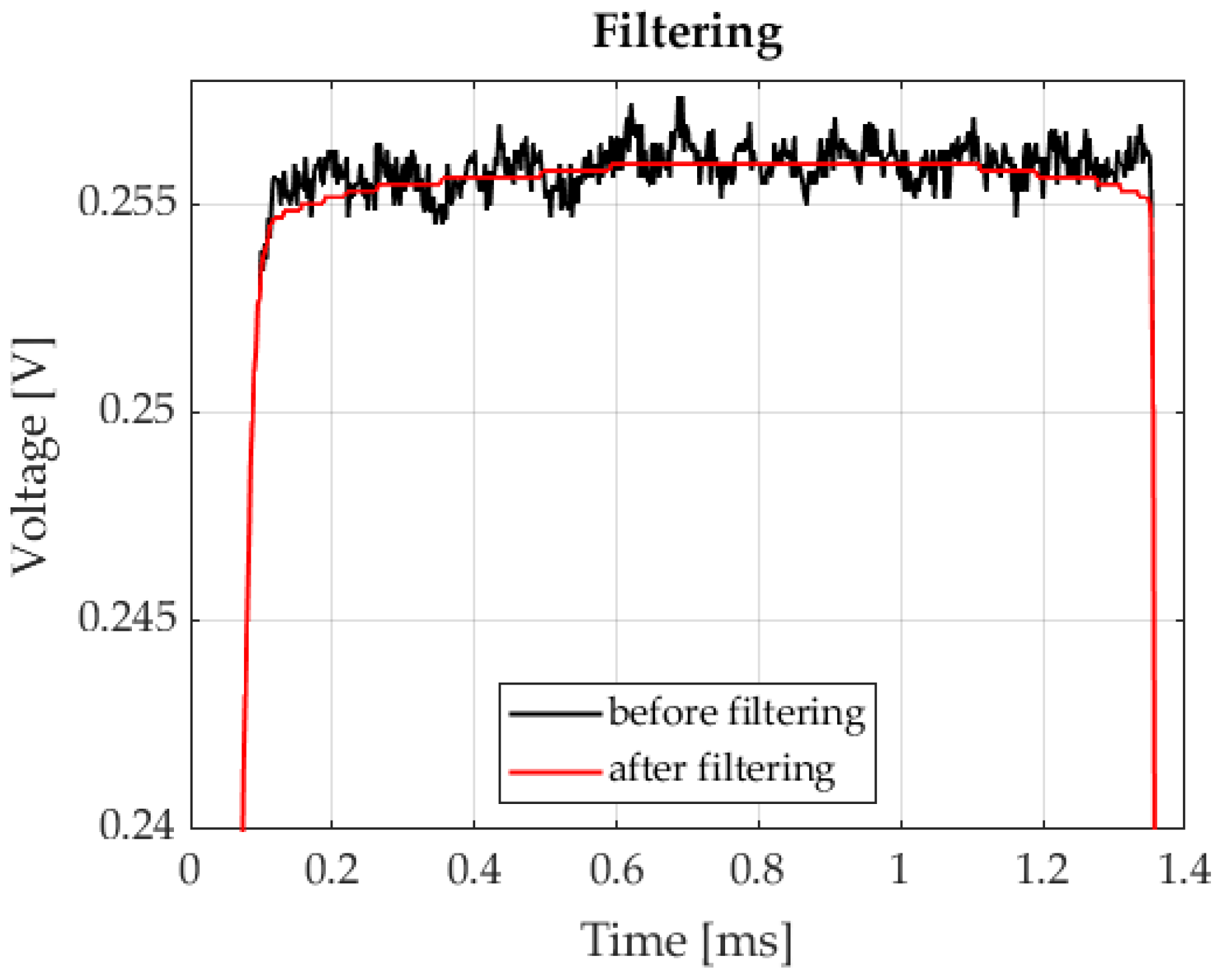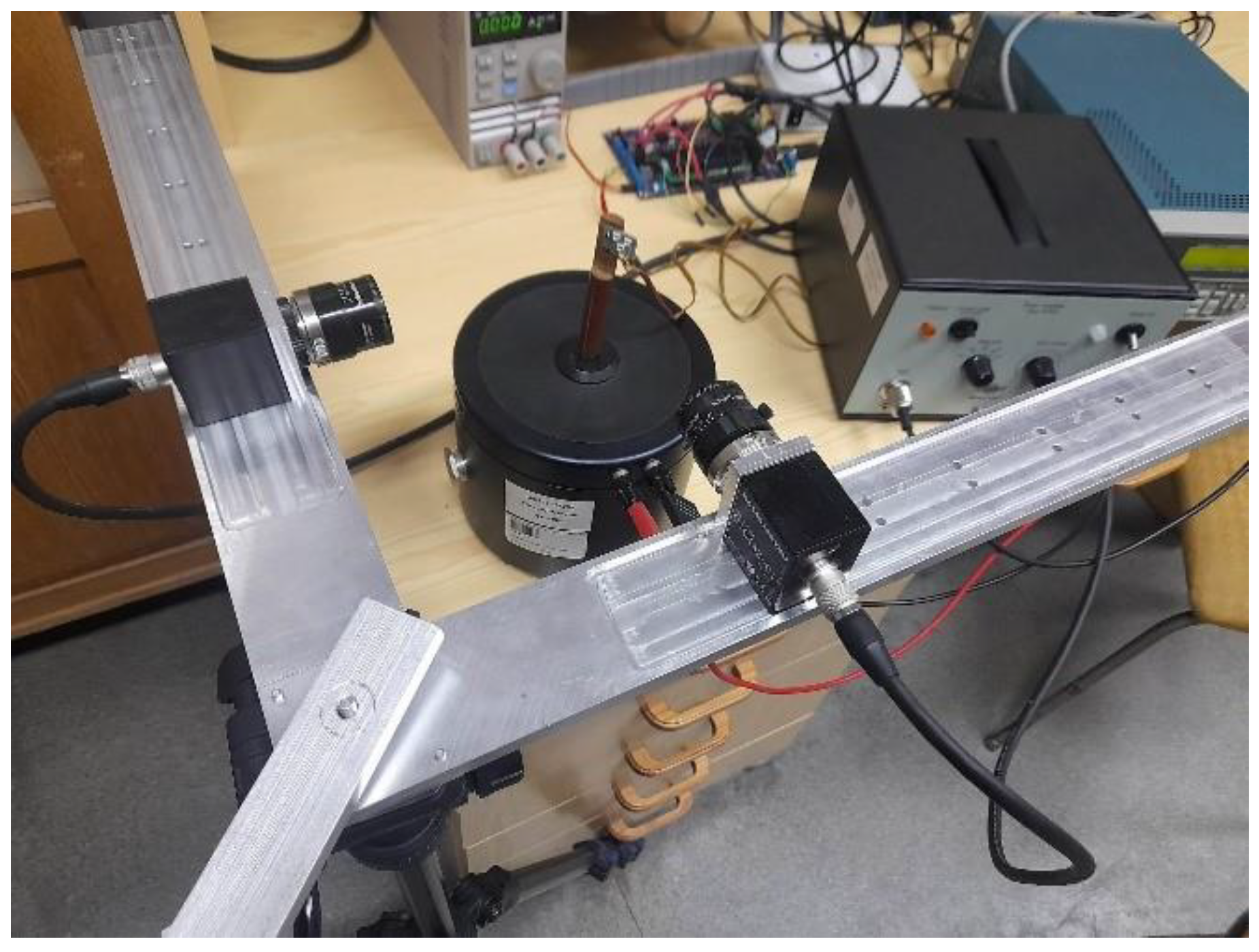Three Dimensional Membrane Vibration Measurement Using a Two Dimensional Position Sensitive Device
Abstract
:1. Introduction
- one degree of freedom and moving in one direction, using a 1D PSD sensor,
- one or two degrees of freedom and moving over a plane, using a 2D PSD sensor.
2. Materials and Methods
2.1. Light Spot Position Determination
2.2. Methods for Determining the Position of Several Markers
- Sequential marker control method;
- FFT-based method.
2.2.1. Sequential Marker Control Method
- D1 diode activation;
- D2 diode activation;
- D3 diode activation;
- Deactivation of all diodes.
2.2.2. FFT-Based Method
- The D1 marker is controlled by a square wave signal with a frequency of 1.0 kHz;
- The D2 marker is controlled by a square wave signal with a frequency of 1.7 kHz;
- The D3 marker is controlled by a square wave signal with a frequency of 2.4 kHz.
3. Results
4. Discussion
5. Conclusions
Author Contributions
Funding
Institutional Review Board Statement
Informed Consent Statement
Data Availability Statement
Conflicts of Interest
References
- Yang, S.; Wang, T.; Yang, L.; Guo, S. A Laser Displacement System Based on PSD with High Anti-interference Ability. In Proceedings of the 2021 IEEE 4th Advanced Information Management, Communicates, Electronic and Automation Control Conference (IMCEC), Chongqing, China, 18–20 June 2021; Volume 4, pp. 786–791. [Google Scholar]
- Zhang, P.; Liu, J.; Yang, H.; Yu, L. Position Measurement of Laser Center by Using 2-D PSD and Fixed-Axis Rotating Device. IEEE Access 2019, 7, 140319–140327. [Google Scholar] [CrossRef]
- Zhang, F.; Li, Y.; Li, H.; Gu, G.H. Compensation method of PSD’s background light based on improved BP neural network. In Proceedings of the 2012 International Symposium on Instrumentation & Measurement, Sensor Network and Automation (IMSNA), Sanya, China, 25–28 August 2012; Volume 1, pp. 151–153. [Google Scholar]
- Jiang, Y.; Zi-xue, Q.; Jian-xin, S.; Jin-wei, C. Position measurement and wireless measurement system of straightness error based on two-dimensional PSD. In Proceedings of the 2010 International Conference on Electrical and Control Engineering, Wuhan, China, 25–27 June 2010; pp. 1490–1492. [Google Scholar]
- Ivan, I.A.; Ardeleanu, M.; Laurent, G.J.; Tan, N.; Clevy, C. The metrology and applications of PSD (position sensitive detector) sensors for microrobotics. In Proceedings of the 2012 International Symposium on Optomechatronic Technologies (ISOT), Paris, France, 29–31 October 2012; pp. 1–2. [Google Scholar]
- Wang, J.X.; Hou, Y.R. Research on robot obstacle avoidance method on PSD and sonar sensors. In Proceedings of the 2016 3rd International Conference on Information Science and Control Engineering (ICISCE), Beijing, China, 8–10 July 2016; pp. 1071–1074. [Google Scholar]
- Zhou, Y.G.; Xie, Y.G.; Yu, G.P.; Zhan, D. Research of 3D spatial localizing system based on PSD sensor. In Proceedings of the 2009 International Conference on Measuring Technology and Mechatronics Automation, Zhangjiajie, China, 11–12 April 2009; Volume 1, pp. 55–58. [Google Scholar]
- Lee, J.G.; Kim, D.M.; Suk, J.Y. Development of a 3D Position Determination Device using PSD sensor. In Proceedings of the International Conference on Control, Automation and Systems, Gyeonggi-do, Korea, 27–30 October 2010; pp. 1733–1736. [Google Scholar]
- Guillaume, P.; Schoukens, J.; Pintelon, R.; Kollar, I. Crest-factor minimization using nonlinear Chebyshev approximation methods. IEEE Trans. Instrum. Meas. 1991, 40, 982–989. [Google Scholar] [CrossRef]
- De-La-Llana-Calvo, Á.; Lázaro-Galilea, J.L.; Gardel-Vicente, A.; Rodríguez-Navarro, D.; Bravo-Muñoz, I. Indoor Positioning System Based on LED lighting and PSD Sensor. In Proceedings of the 2019 International Conference on Indoor Positioning and Indoor Navigation (IPIN), Pisa, Italy, 30 September–3 October 2019; pp. 1–8. [Google Scholar]
- Onishi, K.; Tanaka, D.; Yang, S. Three Dimensional Position Detection Using a Two Dimensional PSD and a Marker Composed of Two Light Sources. In Proceedings of the 2015 International Conference on Intelligent Systems and Image Processing, Fukuoka, Japan, 2–5 September 2015; pp. 92–99. [Google Scholar]
- Rodríguez-Navarro, D.; Lázaro-Galilea, J.L.; Espinosa, F.; De-La-Llana-Calvo, A.; Santos, C. Simplified calibration process for a PSD-based optical IPS. In Proceedings of the 2018 International Conference on Indoor Positioning and Indoor Navigation (IPIN), Nantes, France, 24–27 September 2018; pp. 1–6. [Google Scholar]
- De-La-Llana-Calvo, Á.; Lázaro-Galilea, J.L.; Gardel-Vicente, A.; Bravo-Muñoz, I.; Alcázar-Fernández, A.; Iamitchi, A.; Hernández-Puerta, D. Evaluation of the accuracy and precision of orientation determination in an indoor positioning system using infrastructure illumination and PSD sensors. In Proceedings of the 2021 International Conference on Indoor Positioning and Indoor Navigation (IPIN), Lloret de Mar, Spain, 29 November–2 December 2021; pp. 1–6. [Google Scholar]
- Shi, A.; Liang, Y. A Design of Signal Processing Circuit Based on the Duo-Lateral PSD. In Proceedings of the 5th International Conference on Intelligent Human-Machine Systems and Cybernetics, Washington, DC, USA, 26–27 August 2013; Volume 1, pp. 255–258. [Google Scholar]
- Catalog Note of c10443 Module. Available online: https://www.hamamatsu.com/content/dam/hamamatsu-photonics/sites/documents/99_SALES_LIBRARY/ssd/c10443_series_kpsd1027e.pdf (accessed on 30 November 2022).
- Kawasaki, A.; Goto, M. On the position response of a position-sensitive detector (PSD) irradiated with multiple light beams. Sens. Actuators A Phys. 1990, 22, 534–537. [Google Scholar] [CrossRef]
- Luo, Y.; Shen, Y.; Cordero, J.; Zaklit, J. Enhancing measurement accuracy of position sensitive detector (PSD) systems using the Kalman filter and distortion rectifying. In Proceedings of the Sensors, 2013 IEEE, Baltimore, MD, USA, 3–6 November 2013; pp. 1–4. [Google Scholar]
- Bose, T.; Schroeder, J. Adaptive mean/median filtering. In Proceedings of the 2000 International Conference on Acoustics, Speech, and Signal Processing, Istanbul, Turkey, 5–9 June 2000; pp. 3830–3833. [Google Scholar]
- Daiyan, G.M.; Mottalib, M.A. Removal of high density salt & pepper noise through a modified decision based median filter. In Proceedings of the 2012 International Conference on Informatics, Electronics & Vision (ICIEV), Dhaka, Bangladesh, 18–19 May 2012; pp. 565–570. [Google Scholar]
- Chang, C.C.; Hsiao, J.Y.; Hsieh, C.P. An adaptive median filter for image denoising. In Proceedings of the 2000 Second International Symposium on Intelligent Information Technology Application, Shanghai, China, 21–22 December 2008; pp. 346–350. [Google Scholar]
- Liu, J.; Wang, P.; Tian, X. Vibration displacement measurement based on three axes accelerometer. In Proceedings of the 2017 Chinese Automation Congress (CAC), Jinan, China, 20–22 October 2017; pp. 2374–2378. [Google Scholar]
- Liu, Z.; He, Q.; Chen, S.; Peng, Z.; Zhang, W. Time-varying motion filtering for vision-based nonstationary vibration measurement. IEEE Trans. Instrum. Meas. 2019, 69, 3907–3916. [Google Scholar] [CrossRef]

















| X1 | X2 | X3 | Y1 | Y2 | Y3 | |
|---|---|---|---|---|---|---|
| Std [uV] | 497.8 | 466.2 | 529.4 | 477.6 | 407.5 | 434.3 |
| Vpp [mV] | 3.863 | 3.541 | 4.024 | 3.702 | 3.541 | 3.058 |
| X1 | X2 | X3 | Y1 | Y2 | Y3 | |
|---|---|---|---|---|---|---|
| Std [uV] | 78.0 | 66.7 | 84.2 | 81.3 | 79.3 | 63.3 |
| Vpp [mV] | 0.4829 | 0.4829 | 0.4829 | 0.4829 | 0.3219 | 0.3219 |
| X1 | X2 | X3 | Y1 | Y2 | Y3 | |
|---|---|---|---|---|---|---|
| Std [uV] | 832.3 | 871.4 | 512.0 | 578.9 | 928.3 | 808.9 |
| Vpp [mV] | 10.3 | 3.6 | 5.8 | 18.3 | 7.4 | 13.6 |
| X1 | X2 | X3 | Y1 | Y2 | Y3 | |
|---|---|---|---|---|---|---|
| Std [uV] | 47.6 | 132.1 | 47.4 | 127.2 | 168.0 | 153.5 |
| Vpp [mV] | 0.3713 | 0.7019 | 0.4102 | 0.6287 | 0.9243 | 0.9227 |
| X1 | X2 | X3 | Y1 | Y2 | Y3 | |
|---|---|---|---|---|---|---|
| Std [uV] | 61.4 | 140.5 | 44.6 | 78.6 | 125.0 | 124.8 |
| Vpp [mV] | 0.398 | 0.758 | 0.315 | 0.542 | 0.779 | 0.720 |
| X1 | X2 | X3 | Y1 | Y2 | Y3 | |
|---|---|---|---|---|---|---|
| Std [uV] | 122.8 | 157.5 | 75.2 | 128.1 | 174.7 | 165.1 |
| Vpp [mV] | 2.5 | 0.9 | 0.8 | 6.5 | 3.5 | 2.3 |
| X1 | X2 | X3 | Y1 | Y2 | Y3 | |
|---|---|---|---|---|---|---|
| Std [uV] | 1111.1 | 1065.9 | 196.3 | 657.7 | 497.1 | 1025.9 |
| Vpp [mV] | 4.1 | 4.0 | 1.1 | 2.5 | 2.3 | 4.3 |
| Sequential Method | Method Based on FFT | |
|---|---|---|
| Advantages | -Square wave control signals -Does not require high stability of marker control signal frequency | -Compatible with a square wave control signal -Does not require a trigger signal |
| Disadvantages | -Requires use of a filter to improve measurement accuracy -Trigger signal is required | -Requires use of a windowing function to improve measurement accuracy -Requires high stability of marker control signal frequency |
Disclaimer/Publisher’s Note: The statements, opinions and data contained in all publications are solely those of the individual author(s) and contributor(s) and not of MDPI and/or the editor(s). MDPI and/or the editor(s) disclaim responsibility for any injury to people or property resulting from any ideas, methods, instructions or products referred to in the content. |
© 2022 by the authors. Licensee MDPI, Basel, Switzerland. This article is an open access article distributed under the terms and conditions of the Creative Commons Attribution (CC BY) license (https://creativecommons.org/licenses/by/4.0/).
Share and Cite
Białek, R.; Białek, K. Three Dimensional Membrane Vibration Measurement Using a Two Dimensional Position Sensitive Device. Sensors 2023, 23, 174. https://doi.org/10.3390/s23010174
Białek R, Białek K. Three Dimensional Membrane Vibration Measurement Using a Two Dimensional Position Sensitive Device. Sensors. 2023; 23(1):174. https://doi.org/10.3390/s23010174
Chicago/Turabian StyleBiałek, Rafał, and Kamila Białek. 2023. "Three Dimensional Membrane Vibration Measurement Using a Two Dimensional Position Sensitive Device" Sensors 23, no. 1: 174. https://doi.org/10.3390/s23010174






